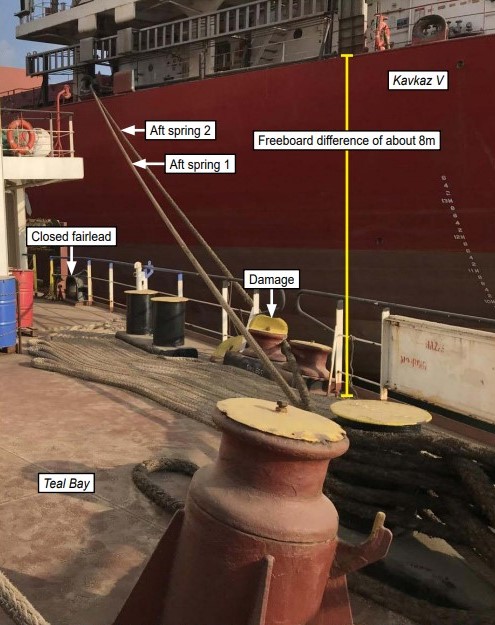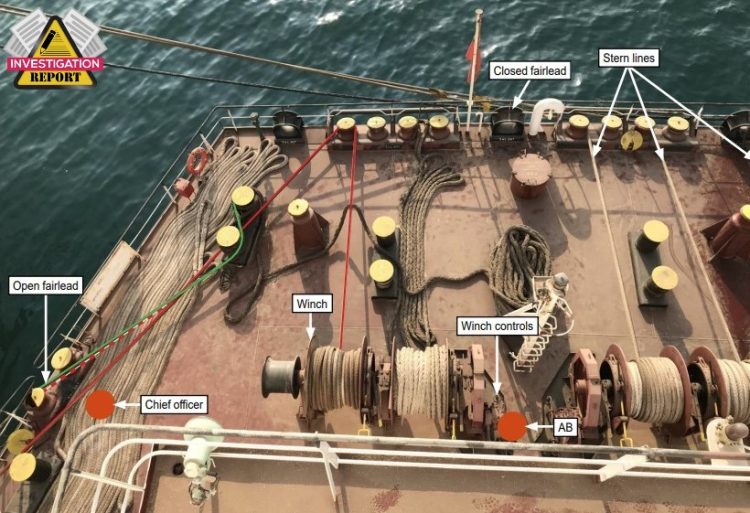UK MAIB published an investigation report on a fatality onboard the cargo vessel Teal Bay, at Kavkaz South anchorage, Russia, on 30 August 2021. The vessel’s chief officer was injured after being struck by a mooring line that sprang free from an open roller fairlead.
The incident
On 29 August 2021, Teal Bay arrived at the Kavkaz anchorage in Russia to load a cargo of grain from the anchored bulk carrier, Kavkaz V, which was acting as a grain storage vessel. At 2215, a pilot boarded Teal Bay and the vessel was moored alongside and prepared for the STS transfer of cargo. The mooring arrangement, agreed between the master and pilot, consisted of three head lines, three stern lines, two forward springs and two aft springs; all lines belonged to Teal Bay. At 0025 on 30 August, Kavkaz V’s crew began loading grain into Teal Bay’s holds using its crane grabs, at which point the two vessels’ freeboards were similar.
[smlsubform prepend=”GET THE SAFETY4SEA IN YOUR INBOX!” showname=false emailtxt=”” emailholder=”Enter your email address” showsubmit=true submittxt=”Submit” jsthanks=false thankyou=”Thank you for subscribing to our mailing list”]
At about 2220, with loading around 80% complete, Kavkaz V’s forward crane operator advised his duty officer that Teal Bay needed to be moved forward to allow the crane grab to reach part of the hold he was loading. By this time, Kavkaz V’s deck was about 8m higher than Teal Bay’s; it was dark, and the wind was light. At 2223, Kavkaz V’s third officer (3/O) called Teal Bay using very high frequency (VHF) radio and requested that the vessel be moved forward 2-3m. Teal Bay’s master instructed the on watch crew and the C/O to proceed to the forward and aft mooring decks to warp the vessel forward using the spring lines.
The master decided not to wake the of watch crew to assist as this would disrupt their hours of rest. When discussing the plan for the warping operation, the master acknowledged that the C/O was tired.
At 2234, with the C/O and an able-bodied seaman (AB) in position on the aft mooring deck and the 3/O and bosun on the forward mooring deck, Teal Bay’s master informed Kavkaz V that they were starting the warping operation. On the aft mooring deck, the C/O was standing close to the vessel’s side with the AB standing by the winch ready to heave in the aft spring. As the bosun slackened the forward springs, the AB began to haul in on one of the aft springs to heave Teal Bay forward. Almost as soon as the mooring line came under tension, it sprang out of its shipside open roller fairlead and struck the C/O’s head as it snapped tight. The C/O fell unconscious to the deck.

The AB used VHF radio to immediately inform the master that the C/O had been struck and injured. Teal Bay’s master directed the crew to provide first aid to the C/O and then called Kavkaz V and Kavkaz traffic on VHF radio to request medical assistance. The master also phoned the agent and company superintendent, requesting a medical evacuation of the C/O, and alerted the nearest Maritime Rescue Coordination Centre (MRCC). The C/O was lying unresponsive on the deck, with no visible injuries; he was breathing, and a pulse was observed. Teal Bay’s second officer (2/O) administered first aid to the C/O, giving him oxygen and attaching a blood pressure monitor and pulse oximeter3. Teal Bay’s portable defibrillator was also brought to the scene.
At 2255, the agent informed Teal Bay’s master that the tug Dobrynya would take the C/O ashore. At 2316, Dobrynya arrived and the tug crew informed Teal Bay’s master that they were awaiting permission from the local port of Taman, Russia, before embarking the C/O and that the agent was trying to organise his evacuation by helicopter.
At 2340, Dobrynya’s crew informed Teal Bay’s master that no helicopter was available and that they would take the C/O ashore. The C/O was transferred to Dobrynya accompanied by the 2/O and another crew member and, at 2350, the tug left Teal Bay. By this time the C/O’s condition had deteriorated and his pulse had weakened. At 0030 on 31 August, Dobrynya arrived at Taman and a paramedic was transferred to the tug at 0045. The paramedic assessed the C/O and checked for responsiveness and vital signs. After observation, and with no response or sign of life, the paramedic declared the C/O to be deceased. A postmortem examination determined he had suffered closed blunt force trauma to the head, traumatic swelling of the brain and a brain haemorrhage.
Analysis
Both COSWP and Teal Bay’s SMS emphasised the hazardous nature of mooring operations and the need to stand clear of lines under tension. However, despite his lengthy seafaring experience, Teal Bay’s C/O positioned himself in a hazardous zone immediately adjacent to the tensioned aft spring during the warping operation.
Choosing to preserve crew rest and considering the short distance to be moved, the master decided not to treat the warping as a mooring operation as that would require waking of watch crew. Instead, only the C/O and those on watch for cargo operations were tasked to conduct the warping. This meant the C/O was working on the aft deck with a single AB, in contrast to mooring operations where he acted in a supervisory role and the aft team of three was led by another officer. Without a full mooring team, the C/O was probably attempting to simultaneously supervise the aft deck and the overall evolution, and this likely contributed to his decision to stand close to the ship’s side where he could monitor Teal Bay’s forward motion while maintaining sight of the AB operating the winch.
Although on board records indicated that the C/O had met the requirements of the hours of work and rest regulations, he was tired when tasked to warp the vessel forward, a point acknowledged by the master. The C/O’s tiredness may have influenced his actions and motivated him to complete the job quickly so he could rest. As the accident occurred almost immediately when the warping started, there was little opportunity for the AB to challenge the C/O’s decision to stand in a hazardous location even if he had recognised it as such.
A combination of a desire to complete the move and a need to monitor both the winch operator and Teal Bay’s forward progression led to the C/O standing in a hazardous location where he had, almost certainly, not appreciated the risk of the spring line jumping out of the fairlead.
Conclusions
- Teal Bay’s C/O was struck on the head and fatally injured by a tensioned mooring line when it sprang out of a roller fairlead and snapped tight.
- The mooring line sprang free because the fairlead in use was open and the lines had developed a hazardous upward lead during STS cargo operations as the difference between the vessels’ freeboard increased.
- Leading two lines through the same fairlead restricted the space available and almost certainly contributed to the loss of spring line 1 containment.
- The number of crew assigned to carry out the warping operation was insufficient and almost certainly influenced the C/O’s decision, which went unchallenged, to stand in a hazardous area.
- There was insufficient planning for both the mooring and the warping; this happened because, for both evolutions, there was a lack of time available to plan and the crew was unfamiliar with STS bulk cargo operations.
- Despite the crew’s efforts and the assistance of the tug Dobrynya, it took over 2 hours for the casualty to be seen by a medical professional. Given the severity of his injuries, it is unknown whether the delays in the C/O receiving medical attention had any bearing on his death; however, the lack of coordination by the parties involved in organising the medical response created delays that lessened his chances of survival.




























































